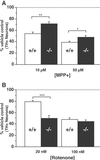Resistance of alpha -synuclein null mice to the parkinsonian neurotoxin MPTP
- PMID: 12376616
- PMCID: PMC137916
- DOI: 10.1073/pnas.172514599
Resistance of alpha -synuclein null mice to the parkinsonian neurotoxin MPTP
Abstract
Parkinson's disease (PD) is most commonly a sporadic illness, and is characterized by degeneration of substantia nigra dopamine (DA) neurons and abnormal cytoplasmic aggregates of alpha-synuclein. Rarely, PD may be caused by missense mutations in alpha-synuclein. MPTP, a neurotoxin that inhibits mitochondrial complex I, is a prototype for an environmental cause of PD because it produces a pattern of DA neurodegeneration that closely resembles the neuropathology of PD. Here we show that alpha-synuclein null mice display striking resistance to MPTP-induced degeneration of DA neurons and DA release, and this resistance appears to result from an inability of the toxin to inhibit complex I. Contrary to predictions from in vitro data, this resistance is not due to abnormalities of the DA transporter, which appears to function normally in alpha-synuclein null mice. Our results suggest that some genetic and environmental factors that increase susceptibility to PD may interact with a common molecular pathway, and represent the first demonstration that normal alpha-synuclein function may be important to DA neuron viability.
Figures





Comment in
-
Etiology of Parkinson's disease: Genetics and environment revisited.Proc Natl Acad Sci U S A. 2002 Oct 29;99(22):13972-4. doi: 10.1073/pnas.242594999. Epub 2002 Oct 21. Proc Natl Acad Sci U S A. 2002. PMID: 12391311 Free PMC article. Review. No abstract available.
References
-
- Scott W. K., Nance, M. A., Watts, R. L., Hubble, J. P., Koller, W. C., Lyons, K., Pahwa, R., Stern, M. B., Colcher, A., Hiner, B. C., et al. (2001) J. Am. Med. Assoc. 286, 2239-2244. - PubMed
-
- Kruger R., Vieira-Saecker, A. M., Kuhn, W., Berg, D., Muller, T., Kuhnl, N., Fuchs, G. A., Storch, A., Hungs, M., Woitalla, D., et al. (1999) Ann. Neurol. 45, 611-617. - PubMed
-
- Polymeropoulos M. H., Lavedan, C., Leroy, E., Ide, S. E., Dehejia, A., Dutra, A., Pike, B., Root, H., Rubenstein, J., Boyer, R., et al. (1997) Science 276, 2045-2047. - PubMed
-
- Kruger R., Kuhn, W., Muller, T., Woitalla, D., Graeber, M., Kosel, S., Przuntek, H., Epplen, J. T., Schols, L. & Riess, O. (1998) Nat. Genet. 18, 106-108. - PubMed
Publication types
MeSH terms
Substances
LinkOut - more resources
Full Text Sources
Other Literature Sources
Medical
Molecular Biology Databases
Miscellaneous

